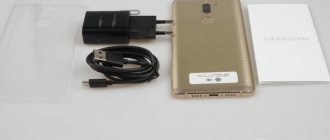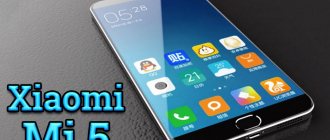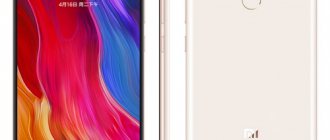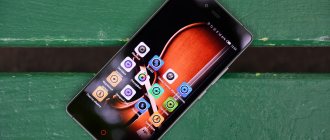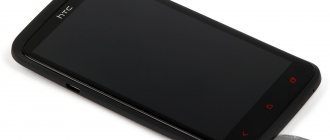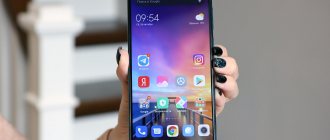The Xiaomi Mi A1 smartphone has been on sale in Russia for two months now. The model is notable for the fact that it was developed in conjunction with Google as part of the Android One program and comes with a pure Android 7.1.2 Nougat system without any shells from the manufacturer and unnecessary applications. Google promises that Android One smartphones will always receive the latest system updates.
It is precisely its belonging to the Android One family that distinguishes the Xiaomi Mi A1 from the Mi 5X model, which comes with the proprietary MIUI shell and is not officially sold in Russia.
Characteristics
| Frame | Aluminum |
| Display | 5.5 inches, FHD (1920 × 1080), LTPS, Corning Gorilla Glass 3 |
| Platform | Qualcomm Snapdragon 625 MSM8953 processor, Adreno 506 graphics accelerator |
| RAM | 4 GB |
| Built-in memory | 64 GB, ability to install memory cards up to 128 GB |
| Cameras | Main – 12 + 12 MP; front - 5 MP |
| Connection | Two nano-SIM slots; 2G: GSM 850 / 900 / 1 800 / 1 900; 3G: 850 / 900 / 1,900 / 2,100; 4G: Band 1, 3, 4, 5, 7, 8, 20, 38, 40 |
| Wireless interfaces | Wi-Fi 802.11a/b/g/n/ac, Bluetooth 4.2, GPS, GLONASS |
| Expansion slots | USB Type-C, 3.5 mm audio jack |
| Sensors | Accelerometer, proximity sensor, ambient light sensor, gyroscope, fingerprint scanner, Hall sensor, infrared sensor |
| operating system | Android 7.1.2 Nougat |
| Battery | 3,080 mAh (non-removable) |
| Dimensions | 155.4 × 75.8 × 7.3 mm |
| Weight | 165 g |
Review of the inexpensive Xiaomi Mi A1 smartphone with an all-metal body and a good dual camera
Content
- Specifications
- Equipment
- Appearance and ease of use
- Screen
- Camera
- Telephone and communications
- Software and multimedia
- Performance
- Thermal photographs
- Playing video
- Battery life
- Bottom line
In early September, Xiaomi presented, in collaboration with Google, its first device under the Android One program - Xiaomi Mi A1. This Google initiative is aimed at creating simple smartphones with a “clean” version of Android and software that is regularly updated over a long period of time. Thus, Mi A1 is a landmark device not only for the Chinese manufacturer, whose first device without its own MIUI shell, but also for Google. Google Vice President of Android and Google Play Jamie Rosenberg said at the presentation: “This is a new step in the development of Android One. We're excited to work with partners around the world to bring quality Android devices to even more users. Mi A1 is a premium design with pure Android, the best built-in Google services, as well as regular software and security updates. We are pleased to welcome Xiaomi and Mi A1 to the Android One family."
Main characteristics of Xiaomi Mi A1 (model MDG2)
- SoC Qualcomm Snapdragon 625, 8 cores ARM Cortex-A53 @2.0 GHz
- GPU Adreno 506 (650 MHz)
- Operating system Android 7.1.2
- Touch display IPS IGZO 5.5″, 1920×1080, 401 ppi
- Random access memory (RAM) 4 GB, internal memory 64 GB
- Nano-SIM support (2 pcs.)
- microSD support
- GSM networks (900/1800 MHz)
- WCDMA/HSPA+ networks (900/2100 MHz)
- LTE networks FDD (B1/3/7/8/20), TD (B38/40)
- Wi-Fi 802.11a/b/g/n/ac (2.4 and 5 GHz)
- Bluetooth 4.2
- USB Type-C, USB OTG
- GPS, A-GPS, Glonass, BDS
- Main camera 12 MP, f/2.2, wide-angle lens, autofocus, 4K video
- Additional camera 12 MP, f/2.6, telephoto lens
- Front camera 5 MP, f/2.0
- Proximity sensor, lighting sensor, magnetic field sensor, fingerprint sensor, gyroscope, step detector, IR port
- Battery 3080 mAh, Quick Charge 3.0
- Dimensions 155×76×7.3 mm
- Weight 162 g
| Average price of Xiaomi Mi A1 |
| Yandex.Market widget |
| Xiaomi Mi A1 retail offers |
| Yandex.Market widget |
Contents of delivery
The packaging of Mi A1 is made in the same style for all the latest Xiaomi mobile products with the most laconic design. The box is made of hard white cardboard and features only the logo, while a summary of the technical specifications is printed on a dust jacket made of thin, flexible cardboard.
The kit consists of a USB cable and a network adapter (5 V 2 A). The key for removing cards is mounted on a cardboard insert as standard. Nothing else is included in the kit.
Appearance and ease of use
Xiaomi Mi A1 has a nice-looking body, thin and not too heavy, with matte surfaces and strongly rounded corners. The picture is completed by the front 2.5D glass, which also has sloping edges that smoothly meet the rounded side edges.
The metal is matte, the surfaces of the case are non-staining, there are no fingerprints on them, even on the black case. True, fingerprints are clearly visible on the round area of the fingerprint scanner, which makes the overall appearance of the smartphone somewhat sloppy.
Xiaomi Mi A1 has dimensions befitting a 5.5-inch display; such a device cannot be called small and elegant. The width of the case is visually further emphasized by its small thickness - only 7.3 mm. The body of the device, in principle, is not slippery, but due to this combination of width and thickness, it is not very securely held in the hand.
The rear panel houses a dual camera module with flash. The flash is also dual, consists of multi-colored diodes, and shines brightly. The camera module protrudes slightly beyond the surface, so it’s not very convenient to work with the smartphone lying on the table, especially considering the rear location of the fingerprint scanner.
The fingerprint sensor area is noticeably recessed. There are no complaints about the operation of the fingerprint scanner; recognition occurs clearly and quickly, and your finger can be placed at any angle.
The front panel is completely covered with 2.5D glass with sloping edges. In the upper part above the screen there are usually sensors, a front camera eye, and an LED event indicator. The milky-colored indicator shines dimly, notifying you of missed events and charging status.
Below the screen there is the usual row of three touch-sensitive hardware buttons, which also received their own backlight. You cannot reassign button functions without an alternative interface.
The side keys are large, they feel the same to the touch, have a soft and pliable stroke, but a clear response. There are no complaints about these elements.
The card slot located on the left side is hybrid: a Nano-SIM card and a memory card or a second Nano-SIM format SIM card are inserted into it.
At the bottom end there is a 3.5 mm headphone output, a speaking microphone hole, a main speaker output, and a USB Type-C connector that supports connecting external devices in USB OTG mode.
At the top end there is an auxiliary microphone for the noise reduction system and an infrared port for emulating a remote control (the smartphone has a pre-installed application for its operation).
The device is available in black, gold and pink colors. The front panel does not always match the overall color of the case: for the pink and gold versions it is simply white. The Xiaomi Mi A1 case did not receive protection from moisture and dust.
Screen
Xiaomi Mi A1 is equipped with an IPS display with 2.5D Gorilla Glass protection. The screen dimensions are approximately 68x121 mm with a diagonal of 5.5 inches. The resolution is 1920×1080, the pixel density is about 401 ppi.
The width of the frame around the sides of the screen is about 3.5 mm, the indents at the top and bottom are approximately 18 mm high.
You can adjust the display brightness manually or use automatic settings based on the ambient light sensor. Multi-touch tests diagnose support for 10 simultaneous touches. The screen cannot be activated by tapping.
A detailed examination using measuring instruments was carried out by the editor of the “Monitors” and “Projectors and TV” sections Alexey Kudryavtsev
. Here is his expert opinion on the screen of the sample under study.
The front surface of the screen is made in the form of a glass plate with a mirror-smooth surface that is scratch-resistant. Judging by the reflection of objects, the anti-glare properties of the screen are not much different from the properties of the Google Nexus 7 (2013) screen (hereinafter simply Nexus 7). For clarity, here is a photo in which a white surface is reflected when the screens are turned off (on the left is Nexus 7, on the right is Xiaomi Mi A1, then they can be distinguished by size):
The screen of the Xiaomi Mi A1 is a little brighter (brightness according to photographs is 129 versus 122 for the Nexus 7). The ghosting of reflected objects in the Xiaomi Mi A1 screen is very weak, this indicates that there is no air gap between the layers of the screen (more specifically, between the outer glass and the surface of the LCD matrix) (OGS - One Glass Solution type screen). Due to the smaller number of boundaries (glass/air type) with very different refractive indices, such screens look better in conditions of intense external illumination, but their repair in the case of cracked external glass is much more expensive, since the entire screen has to be replaced. The outer surface of the screen has a special oleophobic (grease-repellent) coating (about the same efficiency as the Nexus 7), so fingerprints are removed much easier and appear at a lower speed than with regular glass.
With manual brightness control and when the white field was displayed in full screen, the maximum brightness value was about 540 cd/m², the minimum was 2 cd/m². The maximum brightness is very high, and, given the good anti-glare properties, readability even on a sunny day outdoors should be at a decent level. In complete darkness, the brightness can be reduced to a comfortable value. There is automatic brightness adjustment based on the light sensor (it is located to the left of the front camera). In automatic mode, as external lighting conditions change, the screen brightness both increases and decreases. The operation of this function depends on the position of the brightness adjustment slider. If it is 100%, then in complete darkness the auto-brightness function reduces the brightness to 110 cd/m² (too bright), in an office illuminated by artificial light (about 550 lux) it sets it to 420 cd/m² (too high), in a very bright environment ( corresponds to lighting on a clear day outdoors, but without direct sunlight - 20,000 lux or a little more) the brightness increases to 540 cd/m² (to the maximum - this is how it should be). If the adjustment slider is approximately 50%, then the values are as follows: 22, 290 and 540 cd/m² (suitable values); and if at 0% - 2, 150 and 540 cd/m² (the first value is too low). It turns out that the auto-brightness function works adequately and allows the user to customize their work to individual requirements. At any brightness level, there is no significant backlight modulation, so there is no screen flicker.
This smartphone uses an IPS matrix. The microphotographs show a typical IPS subpixel structure:
For comparison, you can see the gallery of microphotographs of screens used in mobile technology.
The screen has good viewing angles without significant color shift even with large viewing deviations from perpendicular to the screen and without inverting shades. For comparison, here are photographs in which identical images are displayed on the screens of Xiaomi Mi A1 and Nexus 7, while the brightness of the screens was initially set to approximately 200 cd/m², and the color balance on the camera was forcibly switched to 6500 K.
There is a white field perpendicular to the screens:
Note the good uniformity of brightness and color tone of the white field.
And a test picture:
The colors on the Xiaomi Mi A1 screen have a natural saturation, the color balance between the Nexus 7 and the tested screen is clearly different.
Now at an angle of approximately 45 degrees to the plane and to the side of the screen:
It can be seen that the colors have not changed much on both screens, but on the Xiaomi Mi A1 the contrast has decreased to a greater extent due to the strong brightening of black.
And a white field:
The brightness of the screens at an angle decreased (by at least 5 times, based on the difference in shutter speed), but in the Xiaomi Mi A1 the decrease in brightness is slightly greater. When deviated diagonally, the black field brightens greatly and acquires a red-violet hue. The photographs below demonstrate this (the brightness of the white areas in the direction perpendicular to the plane of the screens is the same!):
And from another angle:
When viewed perpendicularly, the uniformity of the black field is very good:
The contrast (approximately in the center of the screen) is high—about 1300:1. The black-white-black response time is 27 ms (13 ms on + 14 ms off). The transition between halftones of gray 25% and 75% (based on the numerical value of the color) and back takes a total of 51 ms. The gamma curve, constructed using 32 points with equal intervals based on the numerical value of the shade of gray, did not reveal any blockage in either the highlights or the shadows. The exponent of the approximating power function is 2.22, which is close to the standard value of 2.2. In this case, the real gamma curve deviates little from the power-law dependence:
We did not detect the presence of dynamic adjustment of the backlight brightness in accordance with the nature of the displayed image, which is very good.
Color gamut is close to sRGB:
The spectra show that the matrix filters moderately mix the components with each other:
As a result, the colors have a natural saturation and hue. The balance of shades on the gray scale is a compromise, since the color temperature is much higher than the standard 6500 K, but the deviation from the blackbody spectrum (ΔE) is below 3, which is considered an excellent indicator for a consumer device. Moreover, both parameters change little from shade to shade - this has a positive effect on the visual assessment of color balance. (The darkest areas of the gray scale can be ignored, since color balance there is not very important, and the error in measuring color characteristics at low brightness is large.)
To summarize: the screen has a very high maximum brightness and has good anti-glare properties, so the device can be used outdoors even on a sunny summer day without any problems. In complete darkness, the brightness can be reduced to a comfortable level. It is also possible to use a mode with automatic brightness adjustment, which works adequately. Also, the advantages of the screen include the presence of an effective oleophobic coating, the absence of an air gap in the layers of the screen and flicker, good uniformity of the black field, and a color gamut close to sRGB. Significant disadvantages are the low stability of black to the deviation of the gaze from perpendicular to the screen plane. Nevertheless, taking into account the importance of characteristics for this particular class of devices, the quality of the screen can be considered high.
Camera
The front module has a 5-megapixel sensor and a lens with an f/2.0 aperture without its own flash or autofocus. In addition to the usual modes of decorating a portrait and determining the gender and age of the subject, a group selfie mode has appeared, in which the program takes several consecutive pictures, performs an analysis and produces one common with the best version of the image of each of the faces.
As for the Beautify mode, it can work in automatic mode or with manual settings, and it can also be turned off completely. By default, it is always on, this noticeably changes the appearance of the person in the photo, completely blurring the texture of their skin.
The shooting quality itself is average: even in good daylight, there are both dark and heavily overexposed areas due to the small dynamic range of the 5-megapixel sensor.
The main camera is a set of two modules, one of which has a wide-angle five-element lens with f/2.2 aperture and a 12 megapixel sensor (pixel size 1.25 microns). The second module is also 12-megapixel (pixel size 1.0 microns), it is equipped with a telephoto lens with an f/2.6 aperture (equivalent focal length -50 mm, the lens is also five-element). As a result, the camera provides the ability to double optical zoom, as well as blur the background (with a bokeh effect). There is no optical stabilization, the flash is double, bright.
The menu has manual settings for photo and video shooting (shutter speed (from 1/1000 to 1/15 s), photosensitivity (up to ISO 3200), white balance, and lens selection). But even in the “Pro” mode there is no option to save pictures in RAW.
The camera can shoot video in a maximum resolution of 4K, as well as in Full HD (1920x1080) at 30 fps, but there is no 60 fps mode. As standard, there is a slow-mo mode 720p 120 fps.
The camera copes with video shooting averagely. In daylight everything is fine, but indoors the frame rate drops to 15 per second, and detail drops noticeably. There is no stabilization; even when panning statically with your hands, any shaking is very noticeable; it is almost impossible to make the video sequence smooth here. On top of everything else, the typical Xiaomi disease of the noise reduction system when recording sound was revealed in all its glory, which adds noticeable distortion in the form of an echo, so that the soundtrack of the videos turns into an unintelligible mess.
- Video #1 (67 MB, 3840× [email protected] fps, H.264, AAC)
- Video No. 2 (73 MB, 3840× [email protected] fps, H.264, AAC)
- Video No. 3 (96 MB, 3840× [email protected] fps, H.264, AAC)
- Video No. 4 (60 MB, 3840× [email protected] fps, H.264, AAC)
- Video No. 5 (18 MB, 1920× [email protected] fps, H.264, AAC)
Below are examples of photographs with our comments on quality. Our specialist Anton Soloviev
.
| Good sharpness across the frame. | |
| Good detail on the field and plans. | |
| The camera does macro photography well. | |
| Another example of great macro. | |
| The camera still performs great in low light conditions. | |
| The shadows, of course, are noticeably noisy, but otherwise everything is very good. |
The camera turned out to be good, in some places even very good. There is practically nothing to complain about here. She does not overuse software processing, although weak sharpening can be found if you look at the pictures for a long time. Sometimes noticeable noise appears in the shadows. In general, even in low light, the camera produces very decent results; it is well suited for documentary and art photography.
Telephone and communications
Communication capabilities of Xiaomi Mi A1 include support for data transmission in LTE FDD and TD networks. Including all the most common frequency bands in our country are supported (Band 3, 7 and 20 FDD LTE). The supported set of frequencies may vary depending on the modification, in general it looks like this:
| Mode | Band |
| GSM | B2, B3, B5, B8 |
| UMTS | B1, B2, B5, B8 |
| FDD-LTE | B1, B3, B5, B7, B8, B20 |
| TDD-LTE | B38, B40 |
In the urban areas of the Moscow region, the device behaves confidently, does not lose connection in places where reception is uncertain, and quickly restores the connection. The speed on the LTE network is stable, there are no problems with the 4G connection. Other communications capabilities include support for both Wi-Fi bands (2.4 and 5 GHz) and 802.11ac mode, as well as Bluetooth 4.2. But there is no NFC module in the smartphone.
The navigation module works with GPS (with A-GPS), with the domestic Glonass and the Chinese Beidou. During a cold start, the first satellites are detected within tens of seconds; the positioning accuracy in the Moscow region is average. There is a built-in magnetic field sensor for compass operation.
The phone application supports Smart Dial, that is, while dialing a phone number, a search is immediately carried out by the first letters in contacts. The telephone interface is standard, including in terms of sorting and displaying contacts: sorting is possible by last name or first name, the same with displaying subscriber data when calling.
In conversational dynamics, the voice of a familiar interlocutor is clearly recognizable, there is no extraneous noise, the sound is natural, pleasant to the ear, bright, rich and clear, the volume margin is sufficient. VoLTE support is available. The vibration alert, on the contrary, is not very powerful, and you can skip it.
The platform supports active standby of both SIM cards in 3G/4G simultaneously. That is, a SIM card can be in active standby on the network not only in 2G, but also in 3G, even if another card is assigned to transmit data in 4G (for example, Beeline SIM cards as the main one and Moscow Tele2 are active in standby at the same time) . The interface allows you to pre-select a specific card for sending SMS, voice calls, and data transfer. The cards operate in Dual SIM Dual Standby mode, there is only one radio modem.
Software and multimedia
As a software platform, the Xiaomi Mi A1 uses the Android OS, which is not the latest version 7.1.2 - naturally, with the ability to update over the air (OTA). As was mentioned at the beginning of the article, this smartphone was the first device released by Xiaomi on pure Android OS without its own proprietary MIUI shell, but with the possibility of long-term support. At the same time, at the time of publication of the review, the device had not received the 8th version of Android (more than two months had passed), and at the press conference it was indicated that the speed with which updates would be released would be lower than, say, the same Google smartphones Pixel. As they say, time will tell, but for now let’s look at what’s available.
The interface and settings are completely consistent with pure Android, no changes have been made here. There is a full set of Google Apps applications, a full-fledged Play Store, and there are rudiments of working with gestures (quick access to notifications using the fingerprint scanner and quick access to the camera using the power key). No third-party applications, except Mi Remote Control and a program for communicating with developers (to describe problems and suggestions), are installed on this device.
To listen to music, you use the standard Google Music player with a familiar interface and manual settings, most of which are only available when you connect headphones. From both the headphones and the external speaker, the sound is clear, rich, bright and loud enough, thanks to the dedicated next-generation NXP Smart PA audio chip with support for Dirac HD Sound software technology. The amplifier supports the connection of high-impedance headphones (up to 600 Ohms).
Performance
The Xiaomi Mi A1 hardware platform is based on a Qualcomm Snapdragon 625 single-chip system made using 14-nanometer technology. This SoC includes eight 64-bit ARM Cortex-A53 cores with a frequency of up to 2.0 GHz; the Adreno 506 video accelerator with a core frequency of up to 650 MHz is responsible for graphics processing, with support for the OpenGL ES 3.2 graphics API. The amount of RAM is 4 GB, and the built-in flash memory is 64 GB (there are modifications with a different amount of flash memory). Of these, on average, about 50 GB of storage space and 1.7 GB of RAM are free.
It is possible to expand the memory by installing microSD cards, and applications can be installed on the card. You can also connect external flash drives in USB OTG mode.
Qualcomm Snapdragon 625 is a platform designed for mid-range smartphones. This is no longer the most interesting chip in its category; it was replaced by the Snapdragon 626 with a higher core frequency (2.2 GHz instead of 2.0 GHz). However, the Xiaomi Mi A1 is designed for emerging markets and is offered at a low price, so the cost of components was clearly taken into account when creating this smartphone.
Thanks to the 14 nm process technology, the SoC combines good performance with low power consumption; in the AnTuTu test, the review hero scores more than 60K points, which is a confident average level. The SoC provides reliable performance and in real-life scenarios allows the smartphone to cope with any tasks. There are no problems with games either; all the games we tested, such as Modern Combat 5 and Mortal Kombat X, run without the slightest slowdown.
Testing in comprehensive tests AnTuTu and GeekBench:
For convenience, we have compiled all the results we obtained when testing the smartphone in the latest versions of popular benchmarks into tables. The table usually adds several other devices from different segments, also tested on similar latest versions of benchmarks (this is done only for a visual assessment of the obtained dry figures). Unfortunately, within the framework of one comparison it is impossible to present the results from different versions of benchmarks, so many worthy and relevant models remain “behind the scenes” - due to the fact that they once passed the “obstacle course” on previous versions of test programs.
| Xiaomi Mi A1 (Qualcomm Snapdragon 625) | Sony Xperia XA1 (MediaTek MT 6757) | HTC One X10 (MediaTek (MT6755) | Huawei Nova 2 (HiSilicon Kirin 659) | Nokia 5 (Qualcomm Snapdragon 430) | |
| AnTuTu (v6.x) (bigger is better) | 63361 | 61638 | 50597 | 60485 | 45287 |
| GeekBench (v4.x) (bigger is better) | 873/4014 | 814/3518 | 757/2071 | 904/3513 | 672/2867 |
Testing the graphics subsystem in gaming tests 3DMark, GFXBenchmark and Bonsai Benchmark:
When testing in 3DMark, the most powerful smartphones now have the ability to run the application in Unlimited mode, where the rendering resolution is fixed at 720p and VSync is disabled (which can cause the speed to rise above 60 fps).
| Xiaomi Mi A1 (Qualcomm Snapdragon 625) | Sony Xperia XA1 (MediaTek MT 6757) | HTC One X10 (MediaTek (MT6755) | Huawei Nova 2 (HiSilicon Kirin 659) | Nokia 5 (Qualcomm Snapdragon 430) | |
| 3DMark Ice Storm Sling Shot ES 3.1 (bigger is better) | 463 | 671 | 421 | 413 | 299 |
| GFXBenchmark Manhattan ES 3.1 (Onscreen, fps) | 6 | 15 | 5 | 5 | 10 |
| GFXBenchmark Manhattan ES 3.1 (1080p Offscreen, fps) | 6 | 6 | 5 | 5 | 4,6 |
| GFXBenchmark T-Rex (Onscreen, fps) | 21 | 32 | 17 | 20 | 20 |
| GFXBenchmark T-Rex (1080p Offscreen, fps) | 22 | 21 | 17 | 18 | 16 |
Browser cross-platform tests:
As for benchmarks for assessing the speed of the javascript engine, you should always make allowance for the fact that their results significantly depend on the browser in which they are launched, so the comparison can only be truly correct on the same OS and browsers, and this is possible during testing not always. For Android OS, we always try to use Google Chrome.
| Xiaomi Mi A1 (Qualcomm Snapdragon 625) | Sony Xperia XA1 (MediaTek MT 6757) | HTC One X10 (MediaTek (MT6755) | Huawei Nova 2 (HiSilicon Kirin 659) | Nokia 5 (Qualcomm Snapdragon 430) | |
| Mozilla Kraken (ms, less is better) | 7910 | 9284 | 9992 | 8887 | 12559 |
| Google Octane 2 (bigger is better) | 4885 | 4489 | 3928 | 4828 | 2823 |
| SunSpider (ms, less is better) | 880 | 946 | 1104 | 1310 | 1970 |
AndroBench memory speed test results:
Thermal photographs
Below is a thermal image of the rear
surface obtained after 10 minutes of battery testing in the GFXBenchmark program:
Heating is more localized in the upper part of the device, which apparently corresponds to the location of the SoC chip. According to the heat chamber, the maximum heating was only 31 degrees (at an ambient temperature of 24 degrees), which is very little.
Playing video
To test the omnivorous nature of video playback (including support for various codecs, containers and special features, such as subtitles), we used the most common formats, which make up the bulk of the content available on the Internet. Note that for mobile devices it is important to have support for hardware video decoding at the chip level, since it is most often impossible to process modern options using processor cores alone. Also, you shouldn’t expect a mobile device to decode everything, since the leadership in flexibility belongs to the PC, and no one is going to challenge it. All results are summarized in a table.
| Format | Container, video, sound | MX Video Player | Standard video player |
| 1080p H.264 | MKV, H.264 1920×1080, 24 fps, AAC | plays normally | plays normally |
| 1080p H.264 | MKV, H.264 1920×1080, 24 fps, AC3 | plays normally | cannot be played |
| 1080p H.265 | MKV, H.265 1920×1080, 24 fps, AAC | plays normally | plays normally |
| 1080p H.265 | MKV, H.265 1920×1080, 24 fps, AC3 | plays normally | plays normally, no sound |
Further testing of video playback was performed by Alexey Kudryavtsev
.
We were unable to check the theoretically possible support for adapters for outputting images to an external device due to the lack of an adapter option that connects to the USB Type-C port, so we had to limit ourselves to testing the output of video files to the screen of the device itself. To do this, we used a set of test files with an arrow and a rectangle moving one division per frame (see “Method for testing video playback and display devices. Version 1 (for mobile devices)”). Screenshots with a shutter speed of 1 s helped determine the nature of the output of frames of video files with various parameters: the resolution varied (1280 by 720 (720p), 1920 by 1080 (1080p) and 3840 by 2160 (4K) pixels) and frame rate (24, 25, 30, 50 and 60 fps). In the tests we used the MX Player video player in the “Hardware” mode. The test results are summarized in the table:
| File | Uniformity | Passes |
| 4K/60p (H.265) | cannot be played | |
| 4K/50p (H.265) | cannot be played | |
| 4K/30p (H.265) | Great | No |
| 4K/25p (H.265) | Great | No |
| 4K/24p (H.265) | Great | No |
| 4K/30p | Great | No |
| 4K/25p | Great | No |
| 4K/24p | Great | No |
| 1080/60p | Great | No |
| 1080/50p | Great | No |
| 1080/30p | Great | No |
| 1080/25p | Great | No |
| 1080/24p | Great | No |
| 720/60p | Great | No |
| 720/50p | Great | No |
| 720/30p | Great | No |
| 720/25p | Great | No |
| 720/24p | Great | No |
Note: If both columns have Uniformity
and
Skips
are given green ratings, this means that, most likely, when watching films, artifacts caused by uneven alternation and skipping of frames will either not be visible at all, or their number and visibility will not affect the viewing comfort. Red marks indicate possible problems with playback of the corresponding files.
According to the frame output criterion, the quality of playback of video files on the screen of the smartphone itself is very good, since frames (or groups of frames) can (but are not required) be output with uniform alternation of intervals and without skipping frames. When playing video files with a resolution of 1920 by 1080 pixels (1080p) on a smartphone screen, the image of the video file itself is displayed exactly along the border of the screen, one to one in pixels, that is, in the original resolution. The brightness range displayed on the screen corresponds to the standard range of 16-235: all gradations are displayed in shadows and highlights.
Battery life
The non-removable battery installed in the Xiaomi Mi A1 has a capacity of 3080 mAh. With this battery, the hero of the review demonstrates average results in battery life tests: his book reading time is not long, but he can play videos from YouTube and play games on it for a relatively long time.
In real life, the device behaves the same way as most modern smartphones: it confidently survives until the evening charge, but you can’t count on more.
Testing has traditionally been done at normal power consumption levels without using power-saving features.
| Battery capacity | Reading mode | Video mode | 3D Game Mode | |
| Xiaomi Mi A1 | 3080 mAh | 12:00 pm | 10:00 am | 6:00 am |
| Sony Xperia XA1 | 2300 mAh | 13:00 | 8:30 a.m. | 4 hours 10 minutes |
| HTC One X10 | 4000 mAh | 17:00 | 12:00 pm | 5:00 a.m. |
| Huawei Nova 2 | 2950 mAh | 13:00 | 10:30 a.m. | 4:00 am |
| Nokia 5 | 3000 mAh | 15:20 | 10:30 a.m. | 7:00 am |
Continuous reading in the Moon+ Reader program (with a standard, light theme) at a minimum comfortable brightness level (brightness was set to 100 cd/m²) with auto-scrolling lasted until the battery was completely discharged for more than 12 hours, and when continuously watching videos in high quality (720p) with the same brightness level via a home Wi-Fi network, the device operates for about 10 hours. In 3D gaming mode, the smartphone can work from 4.5 to 6 hours, depending on the specific game.
The smartphone supports fast charging; from its own network adapter (2 A 5 V), the smartphone is charged within 2 hours with a current of 2 A at a voltage of 5 V. The smartphone does not support wireless charging.
Bottom line
The smartphone in a configuration with 4 GB of RAM and 64 GB of internal memory went on sale in Russia in October. You can purchase the device both in the Xiaomi online store and in retail stores. The price for a certified device is 19 thousand rubles. This price is, in principle, acceptable for a balanced smartphone with a neat and attractive all-metal body, a good screen, good cameras, good sound and a wide range of communication capabilities. Autonomy is also satisfactory, and there are no complaints at all about the performance of the hardware platform. Actually, the only disappointing thing about the device is the lack of an NFC module. In addition, we must keep in mind that this is not a typical Xiaomi with the MIUI interface - but this interface has plenty of fans. Here, “stock” Android is used, and while the official firmware does not keep up with Google, and there is no opportunity to install a custom one (including the same MIUI). Still, the model clearly has more advantages than disadvantages, and the opportunity to get a technically well-equipped device at a low price will attract many. Moreover, it is not at all necessary to purchase an officially certified device; experts will always find ways to save money when purchasing in foreign online stores, where the model will obviously be cheaper.
Design
The Xiaomi Mi A1 is said to be similar to the iPhone 7 Plus. However, these two devices have in common only a horizontally located dual camera.
We reviewed a matte black Xiaomi Mi A1. This is a very nice device that pleases the eye. Thin, metallic, with slightly rounded edges, the smartphone is pleasant to hold in your hands.
Mi 10T smartphone - description
Mi 10T, the price of which will start from 550 euros, received a 6.67-inch display made on an IPS matrix. Its main advantage is the “gamer” refresh rate – 144 Hz. The resolution is 2340×1080 pixels. HDR10+ support is provided. The front and back panels are protected from external influences by new generation Gorilla Glass. An aluminum frame is installed around the perimeter of the case. The selfie camera is located in the upper left corner of the screen; it has a minimal diameter. The fingerprint sensor is integrated into the side power button.
Performance
Xiaomi Mi A1 works flawlessly: Android flies, applications do not slow down, Google Assistant quickly responds and searches for the necessary information on the Internet.
The smartphone can handle almost all games. But the most sophisticated ones will have to sacrifice graphics quality. Let's say, in World of Tanks Blitz you will get 60 FPS on medium settings, but in Modern Strike Online even on high settings.
Xiaomi Mi A1 runs on the Qualcomm Snapdragon 625 chipset, a mid-priced processor from the end of 2020. It features eight Cortex-A53 cores clocked at up to 2 GHz and an Adrero 506 GPU.
In AnTuTu testing, the Xiaomi Mi A1 smartphone scores 60 thousand points, typical for its category, and in 3DMark Ice Storm Unlimited - 13 thousand points. The processor heats up insignificantly and throttling does not occur. Performance remains stable.
The amount of RAM is 4 GB, internal memory is 64 GB. It is possible to use a microSD memory card to expand the ROM.
The resources of Xiaomi Mi A1 will be enough for at least another two years, even for those who like to play.
Advantages and disadvantages
The undoubted reason to buy Xiaomi Mi A1 is its affordable price, especially considering the range of options and capabilities of the smartphone. Among the advantages is a clean version of the Android OS, thanks to which users have more independence to install various services and applications.
Due to the weak camera, which clearly does not reach the premium level, the mobile product can safely be considered a strong mid-ranger. The device will confidently and efficiently cope with all the tasks assigned to it, providing the user with comfortable surfing the Internet and watching videos. However, for those who are purchasing a gaming smartphone or are interested in an ultra-efficient device, it is advisable to pay attention to more powerful copies.
Cameras
Xiaomi Mi A1 is called a clone of the iPhone 7 Plus because of its dual camera with 2x optical zoom and portrait mode. However, no one will equip a mid-price smartphone with flagship cameras and technologies. What is installed in it?
The main camera is a 12-megapixel OmniVision OV12A10 module with a 1.25 micron pixel and a wide-angle lens with f/2.2 aperture. There is no optical stabilization, phase detection autofocus.
During daylight hours outside, long shots work well. However, in all other cases, good photographs are rarely obtained. The camera is very picky about lighting. Tiny aperture optics mean you'll be forced to shoot at slow shutter speeds and end up with poor-quality images. The noise breaks all records, and the lens catches glare from light sources so brilliantly, as if you were holding not a modern smartphone, but an ancient “folding phone”. Photos indoors come out dark and out of focus.
Autofocus is slow and inaccurate. Even in static scenes, the camera suffers from back focus. You can forget about shooting fast moving objects and macro photography. However, let's hope that this will be fixed in future firmware.
The second camera is equipped with a 12-megapixel OmniVision OV13880 module with a 1.1 micron pixel and an f/2.6 aperture lens. It is only suitable for taking portraits, but only outdoors and only in good lighting.
Portrait mode in Xiaomi Mi A1 is implemented well. The smartphone software separates the subject from the background, simulating the bokeh effect. It turns out beautifully, but with complex contours the algorithm may make mistakes.
But the front camera pleased me. Although there is a 5-megapixel module installed here, the pictures are bright and sharp. There is an “Improve” mode that removes skin imperfections, bags under the eyes and other signs of aging and fatigue. Sharpness, of course, suffers from it.
It is curious that Xiaomi Mi A1 can recognize the gender and age of a person in the frame. Gender, as a rule, is determined correctly, but age varies depending on the lighting and shadows on the face. Either you are 40 years old, or 19—anything can happen.
Appearance
I can’t call the smartphone anything special in terms of design. What we have in front of us is an ordinary telephone in its classical sense. On the one hand, you can even take it with you to a business meeting - the gadget will even fit under some kind of suit. But there are a few disadvantages. Let's start with the fact that fingerprints always remain on the screen, and it is very difficult not to notice them. It doesn't take much of an expert to understand that there is no oleophobic coating here. But more about the display itself below. Below the screen there are three control keys. They are touch sensitive, without backlight and, please note, red. But, as you might have guessed, the list of buttons does not end there. On the left side there is a “volume rocker” and a lock key. They press well (they don’t cut into the body too much).
The case also has a front camera, a speaker, light and proximity sensors, a microUSB connector, a 3.5 mm audio output, two microphones, a main camera, a flash, a second speaker and an LED indicator (under the Home touch button). In short, a standard set.
The cover on Redmi 1S is removable. And this is where it would be very useful to say that this smartphone can be found in two modifications: an older one (with two SIM cards, but only with 3G) and a newer one (with one SIM card, but with LTE support). So we have a new version with LTE support. To be fair, it is worth noting that there are other differences between these gadgets, related directly to the hardware, so do not rush to draw premature conclusions. First things first.
Assembling a smartphone for a solid four. In principle, everything is quite good, but due to the removable cover, the plastic case creaks a little and in some places (at the back) is pressed in (but not much). By the way, it’s good that this same plastic here is not glossy, so fingerprints are not visible. Over the course of several weeks, no scratches appeared on the back panel of the smartphone. If we talk about dimensions, it’s difficult to call a smartphone compact. With a thickness of 9.9 millimeters, the weight is 158 grams.
Connection
Xiaomi Mi A1 can install two nano-SIM cards. However, the tray here is combined, so you have to choose between a memory card or a second SIM card. The device, officially supplied to Russia, supports the LTE band Band 20, so there should be no problems with the Internet.
The smartphone also supports dual-band Wi-Fi 802.11a/b/g/n/ac, Bluetooth 4.2, GPS, GLONASS and BEIDOU. But for complete happiness, NFC is still not enough.
A nice bonus is the infrared port, which allows you to use your smartphone as a remote control for consumer electronics.
Software
Instead of the original MIUI frontend, which greatly influences the appearance of the Android system, we get Android One. This is almost pure Android, which does not contain any additional applications. On the one hand, this is good because such software is less resource-intensive, but on the other hand, it lacks several interesting MIUI features, such as application cloning.
Apart from looks and functionality, the biggest advantage of Android One smartphones is the speed at which all updates are available. Android One ensures your smartphone receives security and development updates as quickly as possible.
The Xiaomi Mi A3 appears to be the budget counterpart to the Google Pixel 3a. Android One isn't a key feature, so it's better to add some money and opt for the Xiaomi Mi 9T, which offers a more powerful processor and NFC. Mi 9 SE could also be an interesting alternative.
Also reading with this:
- Fashionable and inexpensive. Four best phones for modern teenagers A phone for a teenager should be fashionable, bright, with a high-quality camera and a good speaker. In addition, it must work stably and hold a charge for a long time, since children […]
- USB Type-C: everything you need to know about the new type of connectors The USB port is universal. This is one of the most commonly used communication connectors. USB replaces the legacy serial and parallel ports. A new type of USB connector - USB ports […]
- Smart watches for children rating A smart watch is a device that the youngest users want, just like a smartphone. We present the rating of smart watches for children. First of all, they are distinguished by colorful children's [...]
- LCD or AMOLED? Which smartphone display is better? When choosing a smartphone, we often wonder whether it’s worth paying extra for a model equipped with an AMOLED display, or whether it’s better to go with a classic LCD (also called LCD) screen... […]
- Characteristics of OnePlus Nord: an excellent smartphone for the average user A smartphone that aroused great interest long before its premiere. Finally he is in our hands. After a number of high-end models, this device appears, the purpose of which is to show that […]
Android devices
Display
A 5.5″ matrix with FullHD resolution manufactured by tianma is installed. The display is bright, saturated, everything is readable even in the sun. I was able to compare it head-to-head with the Xiaomi Redmi 4 pro and I can say that the display in the reviewed smartphone has a larger brightness margin, which has a good effect on the readability of the display in the sun.
The display does not have an air gap (OGS), Corning Gorilla Glass 3 has a 2.5D curve. The oleophobic coating is good, the finger glides well, fingerprints are erased easily. The touchscreen is responsive, 10 touches.
Checking the oleophobic coating
Price
Immediately after the launch, prices for Xiaomi Mi A1 started from 17 thousand rubles for the version with 32 gigabytes of memory and 19 thousand rubles for the version with 64 gigabytes of memory. We would say that, from Xiaomi's point of view, these prices were quite optimistic. Now in large retail chains this phone can be found for 12 and 14 thousand rubles, respectively. And such prices can already be called completely acceptable for a device of this level.
Competitors
However, competitors are not asleep; other companies also have quite a lot of interesting smartphones that could compete on equal terms with our today’s hero.
The first candidate is Huawei P10 Lite. Its price is slightly higher, and it runs on a slightly slower HiSilicon Kirin 658. However, this smartphone can offer a very interesting and unusual design, as well as an NFC module that is popular in large cities.
But the Meizu M6 Note already costs a little less, but has the same single-chip system as our hero, while its battery is 4000 milliamp-hours, which is significantly more. Of the minuses, it can be noted that not everyone loves Meizu’s proprietary shell called Flyme.
Among the domestic lines you can also find competitors, and the most obvious of them, in our opinion, is Xiaomi Redmi Note 4X. Yes, this smartphone is much more budget-friendly than the Mi A1, but it is also equipped with a Qualcomm Snapdragon 625 and costs less.
Give gifts
Fitness bracelet Xiaomi Mi Band 4 Silicone strap as a gift!
2 490 ₽
Fitness bracelet Xiaomi Mi Band 3 Silicone strap as a gift!
990 ₽
operating system
Xiaomi Mi A1 is equipped with the Android operating system version 7.1.2, however, unlike other phones from the company, it does not have a proprietary MIUI shell. Instead, we are dealing with practically “naked” Android, brought to mind within the framework of the Google Android One program. Undoubtedly, such a system has many advantages, in particular, it is not burdened with unnecessary, unnecessary programs and will receive updates much more often than the standard shell from Xiaomi. In addition, Xiaomi Mi A1 is guaranteed to be one of the first to receive an over-the-air update of the operating system to version 8.0. And this, as you know, is a very rare occurrence for mid-budget smartphones.
Pure Android works very fast and stable. For many hours we were not “lucky” to observe a single major jamb or freeze. The system is equipped with all standard Google programs and, not surprisingly, boasts pre-installation of all the necessary company services. Of the programs from Xiaomi, we found only a service for feedback from Mi Community developers, as well as a camera and remote control application.
Also among the features of pure Android, one should highlight a very strange setting for indicating the charge of the smartphone. This is neither an advantage nor a disadvantage, but every buyer should know about this feature, so that later it will not be a surprise for him. So, to enable charging percentages, you need to click on the gear in the phone’s curtain, hold it for a few seconds until the additional System UI Tuner settings open, then go to “Advanced settings” and there click on the “Always show charge percentage” submenu. Fun, right? Well, enjoy it for your health.
